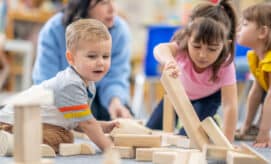Infants and toddlers use their senses to explore the world around them. They find outdoor settings to be particularly exciting, since there is always something new to experience and discover. Digging through sand, observing ants and ladybugs, noticing the fresh scent of plants and the color of leaves and flowers are just a few examples of the sensory learning experiences that young children can enjoy when they play outside. In this article, we highlight some of the benefits of outdoor play for infants and toddlers and share a few tips for creating outdoor spaces that encourage learning.
How Outdoor Play Benefits Infant and Toddler Development
Outdoor environments enhance our ability as educators to support early development and learning, particularly in key areas like motor skill development and physical coordination. Outdoor environments are particularly well-suited for supporting key areas of early development, like motor skills and physical coordination. And, for young children, outdoor experiences are filled with new things to wonder about and explore.
Outdoor Environments Provide Room to Move
Outdoor play areas feature more space to run, crawl, and roll around than is possible in a typical classroom. These experiences are particularly beneficial for infants and toddlers, who are fascinated by all the new ways they are learning to move. Playing outdoors provides a variety of opportunities for infants and toddlers to strengthen muscles, increase coordination, and move through the world.
Many early learning programs feature outdoor play structures that invite children to climb and take risks. This is great for toddlers, who like to challenge themselves to try new things. Some children also enjoy kicking a ball, riding on tricycles, and playing with other materials that encourage them to move their bodies in new ways.
Outdoor Play Offers Sensory Exploration Opportunities
Infants and toddlers enjoy using their five senses to discover the world around them. The feeling of sand, dirt, and grass between toes, the scent of newly cut grass, the sound of a dog barking or the sensation of a breeze through leaves, are just some of the exciting outdoor sensory experiences available to little learners.
Non-nature outdoor sights and sounds are also sources of discovery and learning for children, as described in a video from the Head Start Early Learning and Knowledge Center: “No matter where young children live, the outdoor world offers them interesting things to see, discover, and learn. Everything that happens outside—crawling from grass to a hard surface and being surprised by the change in texture, waving to a mail carrier while out on a neighborhood walk, feeling excitement as a fire truck races by with the siren blaring, looking at the different shapes, sizes, and colors of buildings and street signs—helps children develop social/emotional, physical, cognitive, language, and literacy skills.”
How to Set up an Engaging Outdoor Play Environment
Outdoor environments are a natural source of discovery and learning for young children. Below are some tips and suggestions early educators can use to make their outdoor play spaces even more enriching.
Create Open Spaces
As you look at your outdoor play space, take inventory of the amount of open space where young children can run around freely. Consider re-arranging your yard so that there are a few places in which children can move around. Grass is particularly good for this type of movement because it is soft enough for infants to crawl on and provides a cushion for little ones who could fall down from time to time since their physical coordination is still developing. Sandboxes and areas with evenly paved sidewalk or blacktop surfaces are additional outdoor spots where children can practice their developing motor skills by crawling, walking and running.
Create Opportunities for Sensory Learning
Because exploring with their senses is so valuable for young children, you’ll want to include a variety of items and textures for them to discover in your outdoor space. Sand boxes, large stones or rocks, grassy areas, dirt, and water tables are all fun engagement opportunities for little ones. If you have space, you might even consider creating a small child-friendly garden with taste-safe plants that children can smell, taste, and feel. The variety of textures and colors will invite young children to explore, and can inspire conversations about seeds, flowers, vegetables, colors and other early learning topics.
Observe and Build Upon Children’s Play
When you are outside with the infants and toddlers in your care, observe their play to get a sense of which kinds of equipment and materials interest them the most. If children are spending most of their time in the sandbox, try to ensure that children have access to a variety of materials for sand play. For children who are interested in interacting with their peers, you might offer soccer balls so they can practice rolling or kicking them back and forth with one another. When we observe which types of play and activities the children in our care are drawn to, and notice how children’s interests change, we can build upon those interests to create a more engaging, enriching environment.
Consider Outdoor Safety
Outdoor play with young children requires certain safety and care considerations. It is important, for example, to pay attention to temperature, sun exposure, and hydration, and to avoid hard or sharp surfaces as much as possible. You might find the following health and safety tips useful as you plan outdoor playtime.
- Ensure children have access to water at all times. An easy way to do this is to put all of the children’s water bottles into a basket that can be brought outside. Place the basket in a visible location where children can easily reach their own water when they are thirsty.
- Apply and reapply sunscreen. Have families bring a sunscreen that is safe for their child’s skin and apply it before you take the children outdoors. Make sure that sunscreens are clearly labeled with children’s names so that you know which sunscreen is for which child.
- Ask families to bring wide-brimmed sun hats for their children and encourage little ones to wear them when outdoors. These kinds of hats provide valuable protection from the sun on little ones’ heads and faces, areas that can be particularly sensitive for young children.
- Create shady areas with umbrellas or hanging pieces of fabric so that children can enjoy time outdoors without being in the direct sunlight. This is especially beneficial for younger infants, since they are less mobile. You might offer infants extra sun protection by placing them on a soft blanket in a shady area.
- Consider climbing safety. By keeping climbing structures, slides, and other equipment low to the ground, you can ensure that they are developmentally appropriate for infants and toddlers. When possible, these kinds of structures should be placed on soft landing surfaces, such as sand or grass, to prevent children from being harmed if they fall.
- Ensure that the plants in the outdoor play area are safe for exploration. Flowers and plants are beautiful additions to any early learning play space, but it is important to make sure that they are nontoxic. Infants and toddlers often explore new things by putting them in their mouths, so it is critical for all of the plants in your yard to be safe, and free from any fertilizers or chemicals that children could be exposed to.





